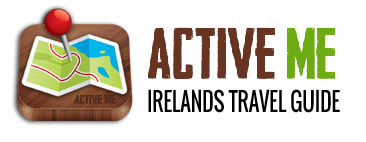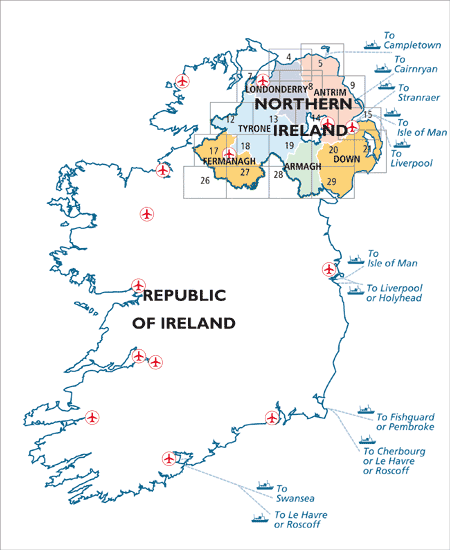Our Map online and on the App are only a guide and should be used in conjunction proper paper map and compass navigation techniques. At all times in the mountains and in remote areas you should bring a suitable map and importantly know how to navigate using it.
Maps for Ireland
There are many maps suitable for the Irish outdoors. See a list of maps here. The entire island of Ireland is covered by 50k (1:50,000) Maps from both Ordnance Survey Ireland’s Discovery Series and the Ordnance Survey Northern Irelands (OSNI), now Land and Property Services (LPS), Discoverer Series. These maps are ideal for route planning and navigation. Use the great ActiveMe maps and GPS info as a guide but purchase the relevant map for proper navigation when on the mountains and off the beaten track. To help you we have tried to provide a Map reference number for all our activities on ActiveMe.
OSi 50k – Discovery Series OSNI (LPS) 50k – Discoverer Series
Map Navigation using a Compass
See below a simple example of compass navigation and taking a compass bearing by Nathan Kingerlee of Outdoors Ireland. This video is a great step by step example but does not include adjusting for magnetic declination if you want an exact bearing.
Taking A Compass Bearing from a Map
Once you have the complete the Steps in the video above, it is important to adjust for magnetic variation. A compass points to magnetic north and not True North (North shown on your map) and changes all the time. Therefore depending on where you are in the world you will have to adjust you compass bearing. For the most up to date magnetic variation for your location can be found here but you can also check the map you are using (but this may be out of date). Here are the 2014 Magnetic Variations for a number of mountains in Ireland. As one mark or notch on your compass is 2 degrees, these numbers should be rounded up or down to the closest degree.
- Carrauntoohil Mountain, MacGillycuddy’s Reek, Co. Kerry, Ireland is 5.56 Degrees West of True North changing by 0.18 Degrees East per year
- The Twelve Pins Mountains, Connemara, Galway is 5.22 Degrees W
- The Wicklow Mountains, Wicklow is 3.72 Degrees W of True North changing by 0.17 Degrees East per year
- The Galty Mountains, Tipperary is 4.28 Degrees (Rounded to 4 Degrees or 2 marks or notches)
- In Ireland you ADD the Magnetic Variation to the map bearing.
Kerry Example: You want to get from Point A (your known location on the Map) to Point B. Once you have taken your bearing from the Map (A to B), lift up the compass and read the bearing indicated on the compass dial. Note this down or remember it and then ADD on the magnetic variation for Kerry (e.g. if you bearing is 140 degrees add on variation 6 degrees which equals 146 degrees). Now move the compass dial to this setting but confirm in your head before you move the compass (to avoid making a mistake). Now you compass is set for A to B. Your compass is now set. Hold the compass in your hand and move your body around until the needle of the compass is correctly aligned with the north – south markings on the housing. The direction of travel arrow on the compass now points in the direction you need to travel to your next destination (point B). Repeat this for any number of points to get to your final destination (i.e. B to C, C to D, etc)
Taking a Bearing between to Landmarks (Mountain Peaks)
If you want to travel from one point to another (A to B), you can take a bearing from your location (A) to the visible destination (Point B). For example you may want to walk from one mountain peak to another but to get there, you have to descend into a wooded valley where Point B would not be visible.
To take a bearing, point the direction of travel arrow on your compass to Point B. Now turn the compass dial until the needle of the compass is correctly aligned with the north – south markings on the housing. The direction of travel arrow on the compass now points in the direction you need to travel to your next destination (point B). Pick a visible landmark a short distance away and walk to this and then repeat the process until you reach Point B. Repeat this for any number of points to get to your final destination (i.e. B to C, C to D, etc).
Finding where you are on a Map
Knowing your current location on the map is essential to navigation. The process is called resection by using two known landmarks on the map to determine your own location.
- Select the first landmark you can identify on the map and is visible (i.e a mountain peak,etc).
- From your current location point the compass at the landmark
- Now, turn the compass dial until the compass needle and the north – south markings on the housing align
- Read the bearing on the dial and then subtract the degrees of Magnetic Variation (see above).
- Place the compass on the map with the edge of the base plate on the symbol for identifiable feature.
- Now move the whole compass around this point until north – south lines are parallel with map grid lines.
- Once complete you can draw a line along the side of the base plate. Your location is somewhere along this line.
- Next, you select another Landmark which can be identified on the map and seen from your position and repeat the process (1 to 7)
- Try a pick a landmark which is nearly 90 degrees from your position so the lines will cross nice and easy.
- Where the two lines cross in your location on the map.
- To confirm you location you can repeat the process again to make sure.
Training Courses
You should also consider doing some training to give yourself more confidence and importantly the techniques and experience to navigate safely in the mountains and deal with most eventualities, such as thick mist, night navigation, emergencies or exposed ground. Mountaineering Ireland have list of courses by location here.


